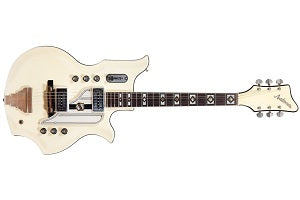If you can’t beat em’ with wood then “Res-O-Glas” will do. That’s the marketing department’s fancy way of describing fiberglass so it doesn’t sound so scary.
Valco released the first Res-O-Glas guitars in 1961 through their National guitar brand and since the bodies were synthetic and mold-cast any shape was fair game. Why not push the limits with horns, cutouts and curves?
The cream of the crop was introduced in 1962, the National Glenwood 99 and this body style has since become known as the “map” guitar since it resembles the shape of the USA. It had a number of cousins, the Glenwood 95 & 98, Newport, and Westwood (made of wood).
The pickups are oversized single coils making for a humbucker look. There was a third pickup under the bridge, the Silver Sound pickup, and it predated the piezo in an attempt to provide an acoustic option. It failed.
The exclusive VAL-TROL controls provided a separate volume and tone for each pickup giving the option for presets of each selection.
Other high-end appointments include fancy pearl inlays, a raised “National” headstock logo, Bigsby tailpiece (optional), and Grover Rotomatic tuners.
Last but not least, a five year guarantee for a warp-free, magnesium core constructed neck.
Bob Dylan played one on his Rolling Thunder Revue tour in the mid 70s and Rick Nielson of Cheap Trick was also a fan (he likes some wild guitars).
A little about Valco during the 1950s and 60s
The company produced all kinds of guitar centric products including pickups and amps mostly for other brands. Its two house guitar brands were National and Supro, but also provided instruments for Silvertone, Academy, and Oahu. Amps were built for Gretsch and JC Penny. Valco was bought by Kay in 1967 and went out of business a year later.



